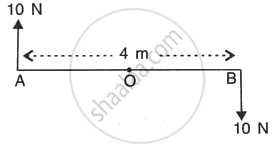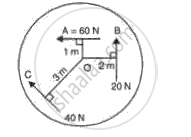Advertisements
Advertisements
प्रश्न
उत्तर
The physical quantity is 'torque'.
Torque may be defines as the turning effect produced by a force on a rigid body about a point, pivot or fulcrum. It is measured by the product of force and the perpendicular distance of the pivot from the line of action of force.
APPEARS IN
संबंधित प्रश्न
How does the magnitude of this non-contact force on the two bodies depend on the distance of separation between them?
An effort is applied on the bigger wheel of a gear having 32 teeth. It is used to turn a wheel of 8 teeth. Where it is used.
A force is applied on (i) a non-rigid body and (ii) a rigid body. How does the effect of the force differ in the above two cases?
A force always produces both the linear and turning motions.
State one factor on which the magnitude of a non-contact force depends. How does it depend on the factor stated by you?.
State Newton's first law of motion. Why is it called the law of inertia?
Two forces each of magnitude 10 N act vertically upwards and downwards respectively at the two ends A and B of a uniform rod of length 4 m which is pivoted at its midpoint O as shown in the figure. Determine the magnitude of the resultant moment of forces about the pivot O.

Three forces A, B and C are acting on a rigid body which can turn about O in fig.9. If all the three forces are applied simultaneously, in which direction will the body move? Explain.

The diagram shows a uniform metre rule weighing 100gf, pivoted at its centre O. Two weights 150gf and 250gf hang from the point A and B respectively of the metre rule such that OA = 40 cm and OB = 20 cm. Calculate :
the total clockwise moment about O

What is meant by the term ‘moment of force’? If the moment of force is assigned a negative sign then will the turning tendency of the force be clockwise or anti-clockwise?
